In last month’s Cooper Hewitt Short Story, we buttoned up with a rousing exploration of the history of the button as illustrated by Cooper Hewitt’s expansive collection. This month, we delve into the uniquely Cooper Hewitt collection of historical and contemporary wallcoverings. Greg Herringshaw, the museum’s curator of wallcoverings, outlines three key areas collected by the Hewitt sisters, and how the wallcoverings department has grown from then.
Margery Masinter, Trustee, Cooper Hewitt, Smithsonian Design Museum
Sue Shutte, Historian at Ringwood Manor
Matthew Kennedy, Publishing Associate, Cooper Hewitt, Smithsonian Design Museum
Medieval leathers to Digital Prints
Eleanor and Sarah Hewitt began collecting wallpapers for the Cooper Union Museum in 1900, and today the Wallcoverings collection at Cooper Hewitt, Smithsonian Design Museum is the largest in North America, containing over 10,000 samples. The Hewitt sisters confined their wallcoverings acquisitions to three main areas: gilt leathers, antique wallpapers, and American bandboxes. They had collected nearly 500 wallcoverings by the time of Sarah’s death in 1930 (Eleanor died in 1924). This included 104 gilt leather wallcoverings, 64 bandboxes, and nearly 300 wallpapers, primarily French, from the late eighteenth and early nineteenth centuries. Due to space constrictions, Eleanor and Sarah made a general rule not to collect or exhibit any objects produced after 1825. They had an eye for quality, and, while most of the wallpapers they collected show exquisite design and craftsmanship, many of the pieces had condition issues. But as the objects were acquired to inspire students, designers, and the public, this was not viewed as a problem.
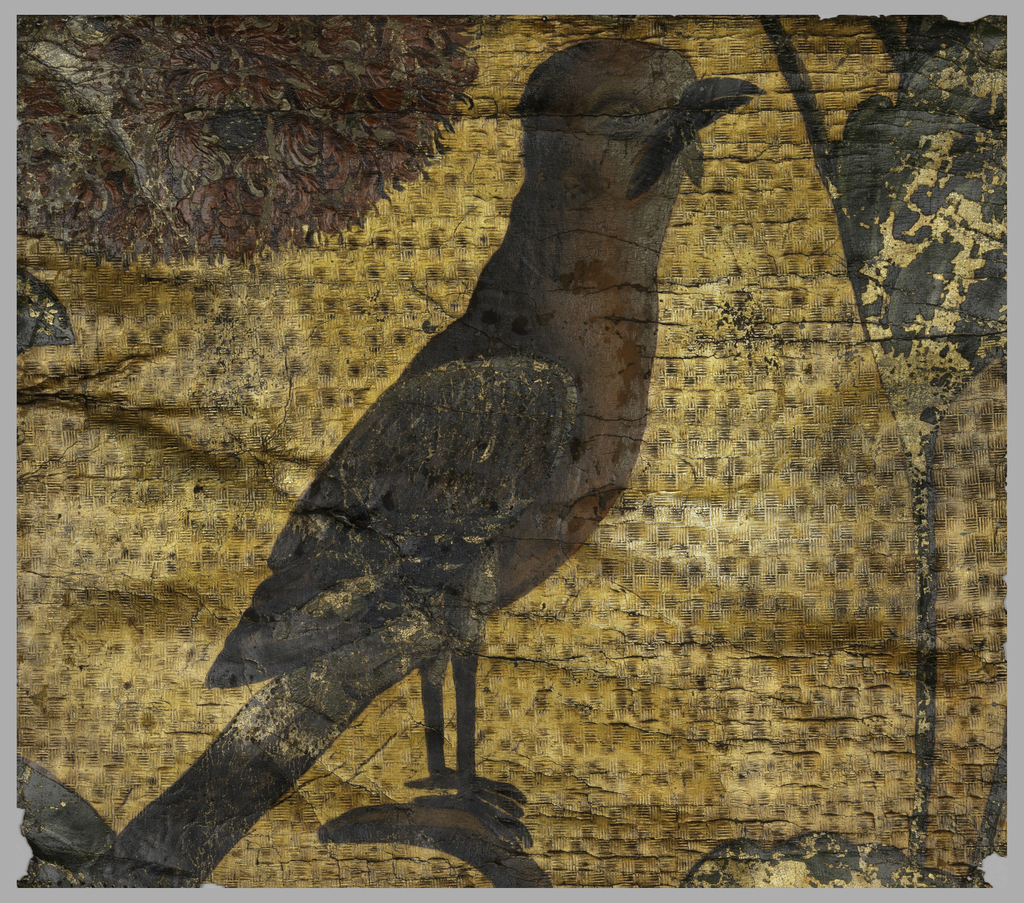
Leather, 1750–99; Leather, painted, varnished, stamped; H x W: 32 x 28 cm (12 5/8 in. x 11 in.); Gift of George Arnold Hearn, 1903-9-13-a,b
Gilt leather wallcoverings have been produced since the middle ages and originally consisted of a painted design over a smooth gilt leather surface. Wood molds used to press a relief pattern into the leather’s surface were developed in Holland in 1628 and made a noticeable change in the appearance of the leathers. Gilt leather wallcoverings were produced by covering the tanned hides with tin-foil, then coating with yellow varnish to create the appearance of gold. The leather was then pressed into a mold to create a relief pattern, and finally the design was painted on using oil colors. These were used for wallcoverings, folding screens, and upholstery, as well as pouches and to wrap boxes. Some of the early leathers donated to the collection came from Mrs. James O. Green—aka Amy Hewitt (1856–1922), sister of Eleanor and Sarah—who made frequent donations to support their museum. Another large group of leathers was donated by George A. Hearn, founder of Hearn’s Department store and collector of contemporary American art. He was also a major benefactor to the museum, offering both financial assistance and objects for the collection.
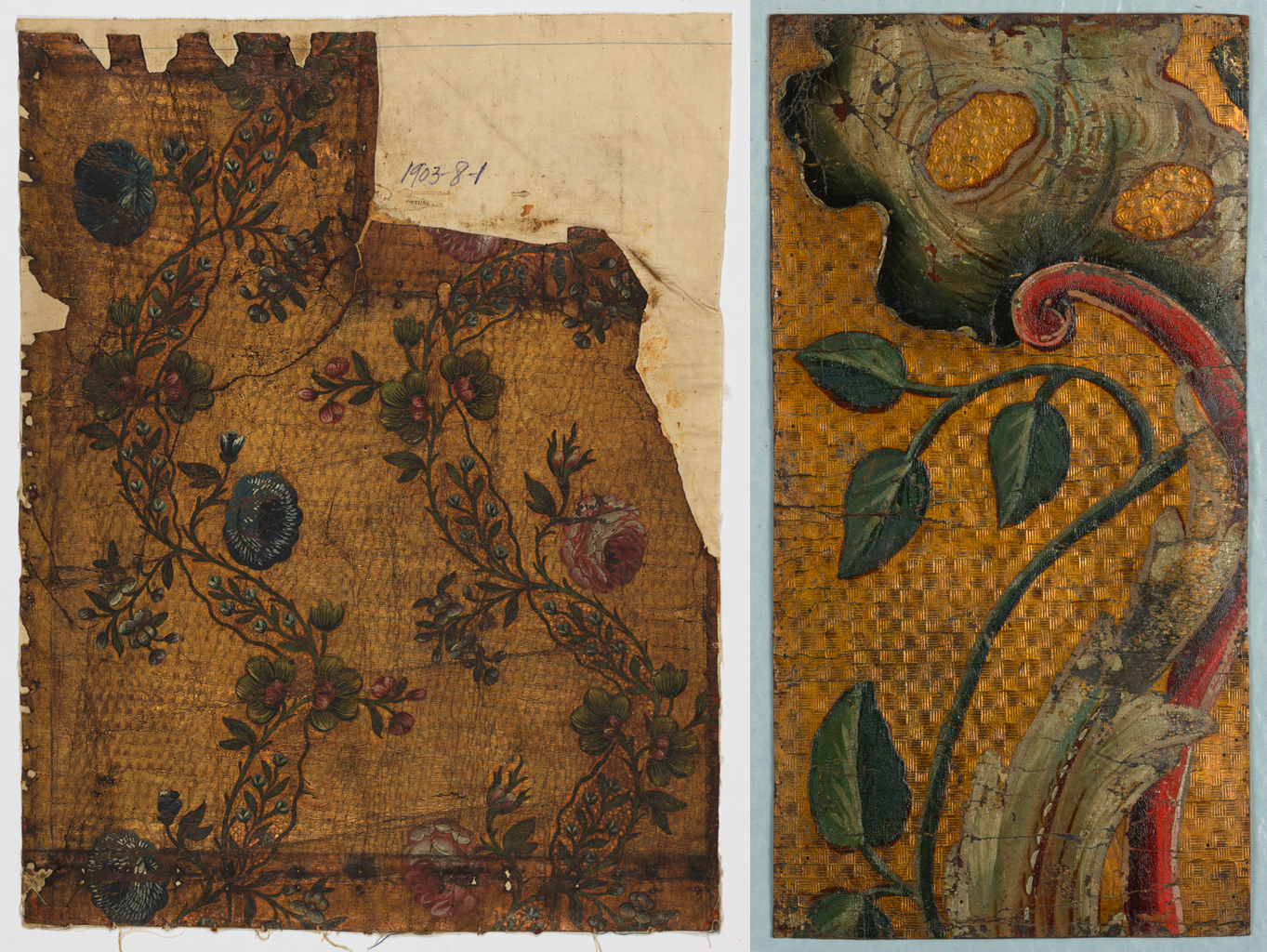
(left) Leather, ca. 1750; Gift of Mrs. James O. Green, 1903-8-1. (right) Leather (Holland), ca. 1700; Gift of Eleanor Garnier Hewitt, 1903-12-5
Bandboxes were initially used for storing and transporting men’s collar bands, but sizes evolved to accommodate hats and for use as general carryalls. In America, bandboxes were most popular from about 1800 to 1850. Most often these boxes were composed of pasteboard stitched together and covered with either wallpaper or specially printed bandbox papers. The more interesting boxes were covered with bandbox papers documenting historic events produced during the 1830s and ‘40s, including a record-setting hot air balloon launch, the Erie or Grand Canal, the first steam-powered boat, and Castle Garden in New York City. Many of the museum’s boxes had come from the collection of Alexander Wilson Drake, the artist, author, and passionate collector. Another group was donated by Amy Hewitt.
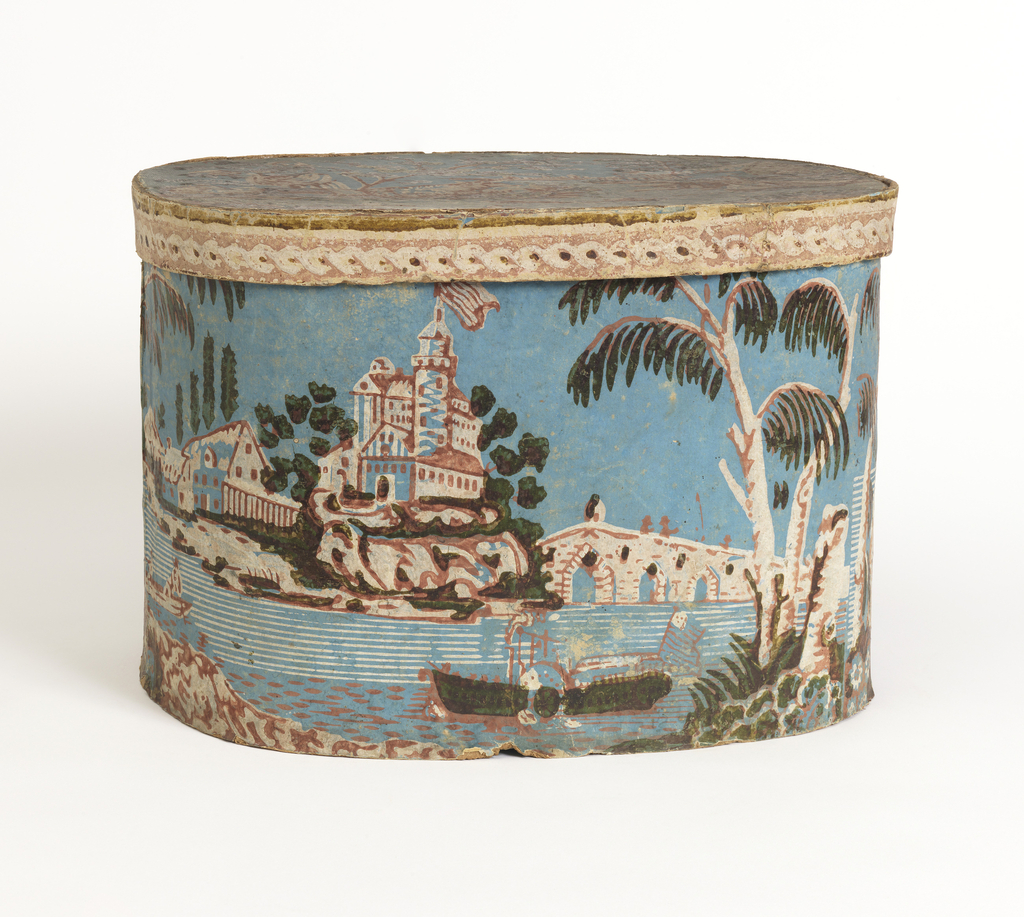
Bandbox, Walking Beam Sidewheeler, ca. 1840; Block printed paper on pasteboard support; 39.5 x 29 x 26 cm (15 9/16 x 11 7/16 x 10 1/4 in.); Gift of Mrs. Frederick F. Thompson, 1913-45-8-a,b
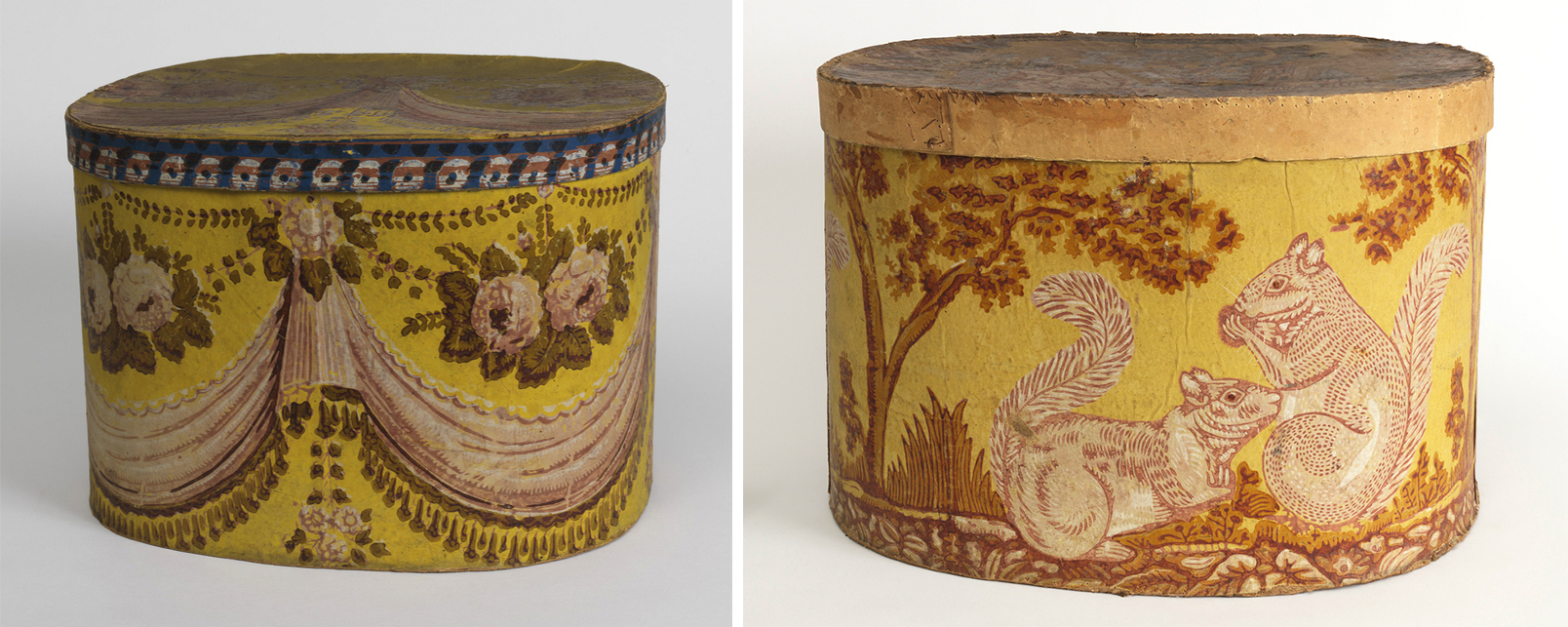
(left) Bandbox with Drapery Wallpaper (USA); ca. 1830; Gift of Eleanor and Sarah Hewitt, 1913-17-26-a,b. (right) Bandbox with Squirrels (USA); ca. 1830; Gift of Alexander Wilson Drake, 1913-9-1-a,b
The antique wallpapers the sisters collected include a mix of borders, friezes, dados, sidewall papers, firescreens or overdoors, and domino papers, designed to cover every part of the wall. The first wallpaper collected was produced by premier French manufacturer John-Baptiste Réveillon, whose factory was one of the first casualties of the French Revolution. The paper is from the John Lincklaen house in Cazenovia, New York, said to have been hung in honor of the marriage between John Lincklaen and Helen Ledyard. This was donated by Mrs. Charles S. Fairchild (Helen Lincklean, great granddaughter of John), whose husband served as Secretary of the Treasury under Grover Cleveland and was a leader on Wall Street. A political figure in her own right, Helen worked alongside Eleanor Hewitt on the New York State Association Opposed to Suffrage. Leading wallpaper manufacturers and distributors also pitched in and donated papers from their archives, including Cowtan & Sons, Ltd., Charles Grimmer & Son, W.H.S. Lloyd Co., Inc., and Richard Thibaut, Inc.
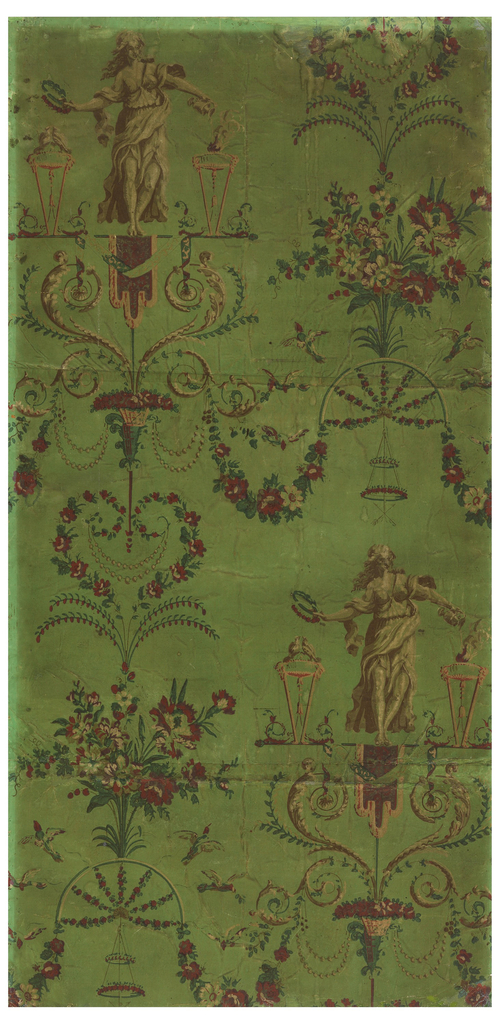
Sidewall (France), 1785–90; Made by Jean-Baptiste Réveillon (French, 1725–1811); Block printed on handmade paper; H x W: 107 x 52.5 cm (42 1/8 x 20 11/16 in.); Gift of Mrs. Charles S. Fairchild, 1900-5-3
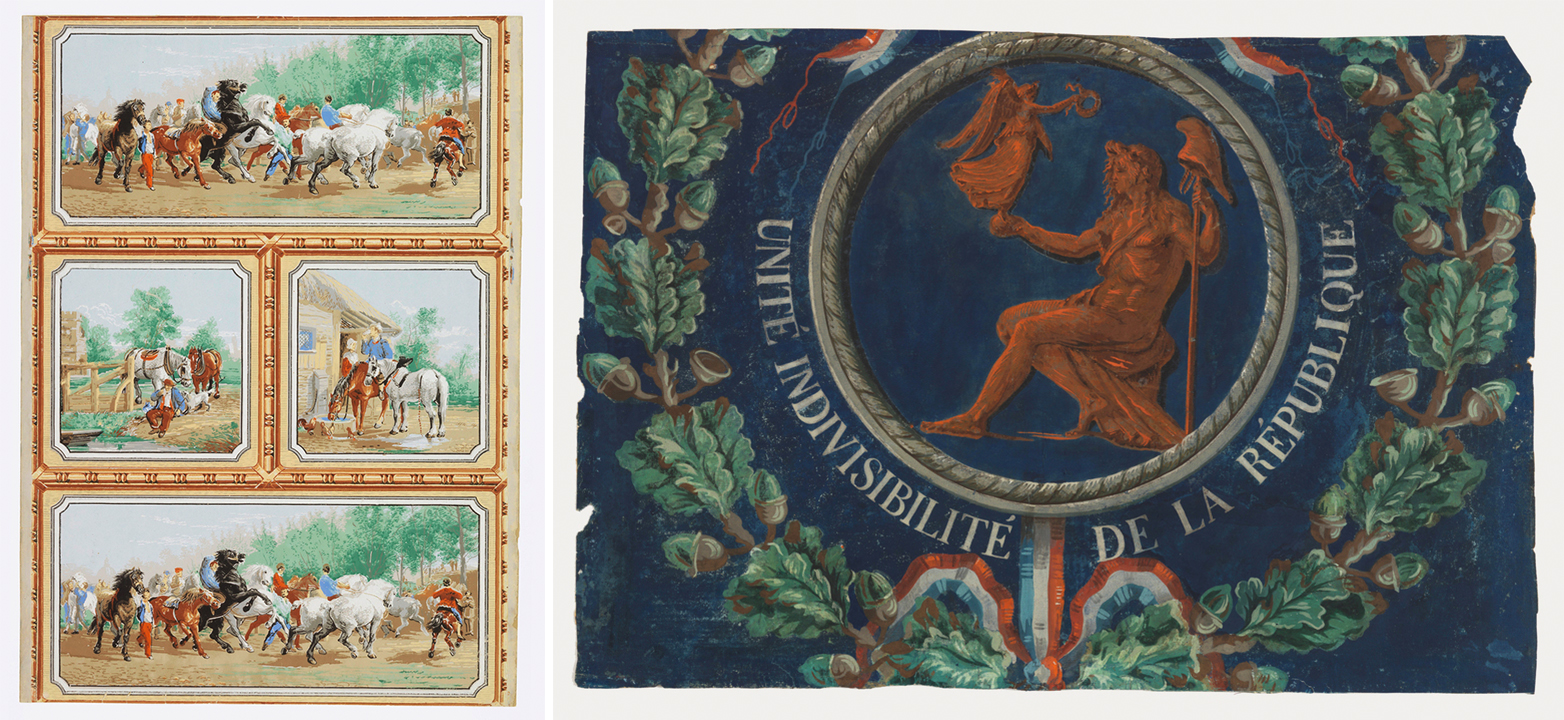
(left) Wallpaper with Scenes from The Horse Fair by Rosa Bonheur, 1855–75; Gift of Eleanor and Sarah Hewitt, 1928-2-73. (right) French Revolution Wallpaper, 1792–93; Jacquemart & Benard (Paris, France); Purchased for the Museum by the Advisory Council, 1925-1-370
Records indicate the museum acquired its first contemporary wallpapers in 1930. These were predominantly modernist in design, produced in Germany, Austria, France, and the USA. Many of the smaller samples were pasted into the legendary scrapbooks maintained by the Hewitt sisters, of which over one thousand were created. These scrapbooks contained designs of every aspect of the decorative arts and were readily accessible for study. (FN 1) Other modernist wallpapers were given for an exhibition at the Cooper Union in 1930. (FN 2) The wallpapers were donated by a number of prominent sources, including the Paul Frankl Gallery and wallpaper distributor W.H.S. Lloyd.
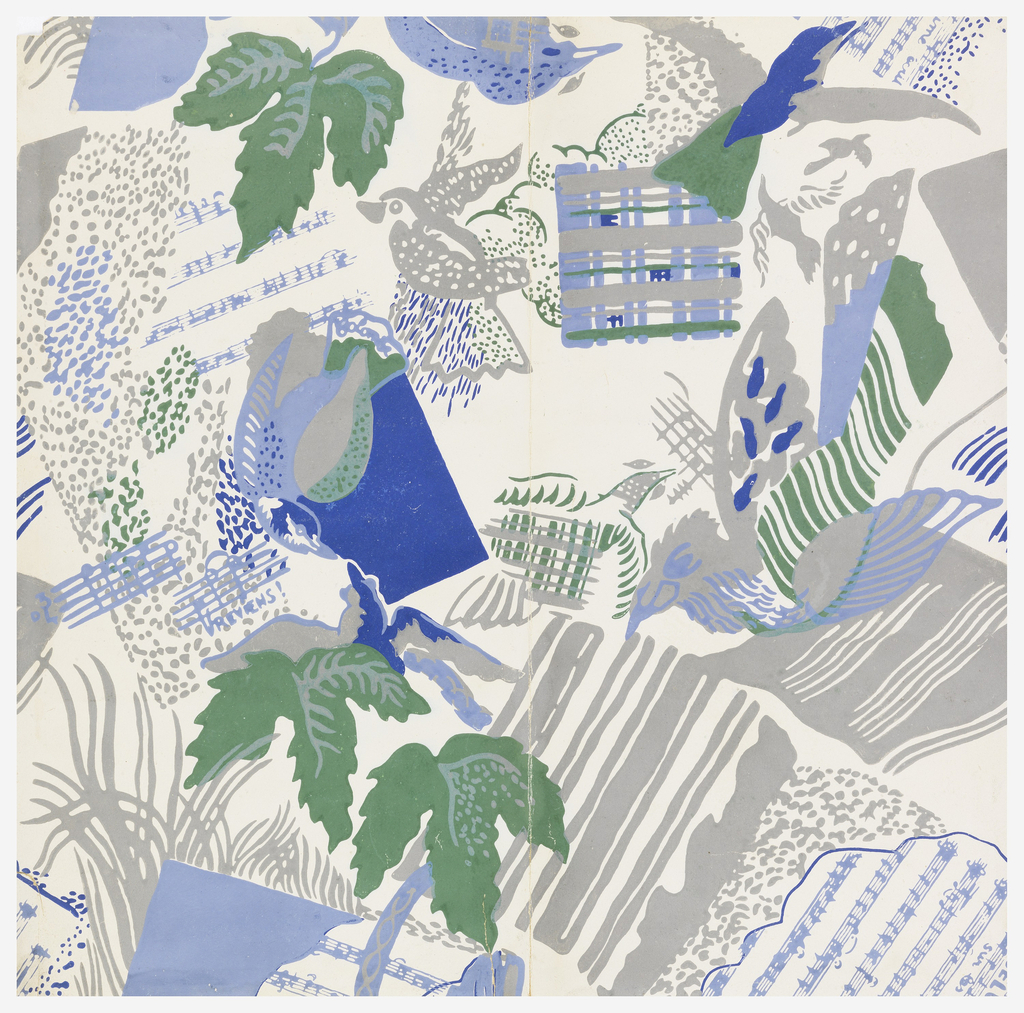
Sidewall, Celui qui aime ecrit sur les murs [One who loves writes on the walls], ca. 1924; Designed by Jean Lurçat (French, 1892–1966); France; block printed on paper; Overall: 47.5 x 47 cm (18 11/16 x 18 1/2 in.); Gift of Mrs. Cornelius Sullivan; 1930-21-1-e

(left and right) Sidewalls, European Wallpapers: Modern Designs, 1928; Designed by Tommi Parzinger, Paul Poiret and Dagobert Peche; machine printed on paper; Gift of Lois and William Katzenbach, 1969-167-1-21
The popularity of wallpaper has had its ups and downs, as all trends do. When the Cooper Union Museum began collecting wallpaper in 1900, the fashion for papered walls was at an all-time high. Developments in machine printing made wallpaper very affordable, while hand woodblock-printed wallpapers were still being produced by a handful of prestigious manufacturers. Wallpaper remained in high demand until the start of the Great Depression in 1929, with continued dips during the war years when government-imposed moratoriums limited production, but came back with renewed vigor in 1946. At this same time silk-screen printing was changing the look of wallpapers as small print runs allowed studios to print specialty papers for niche markets. In contemporary design, digital printing again changed the market by allowing designs to be scalable.
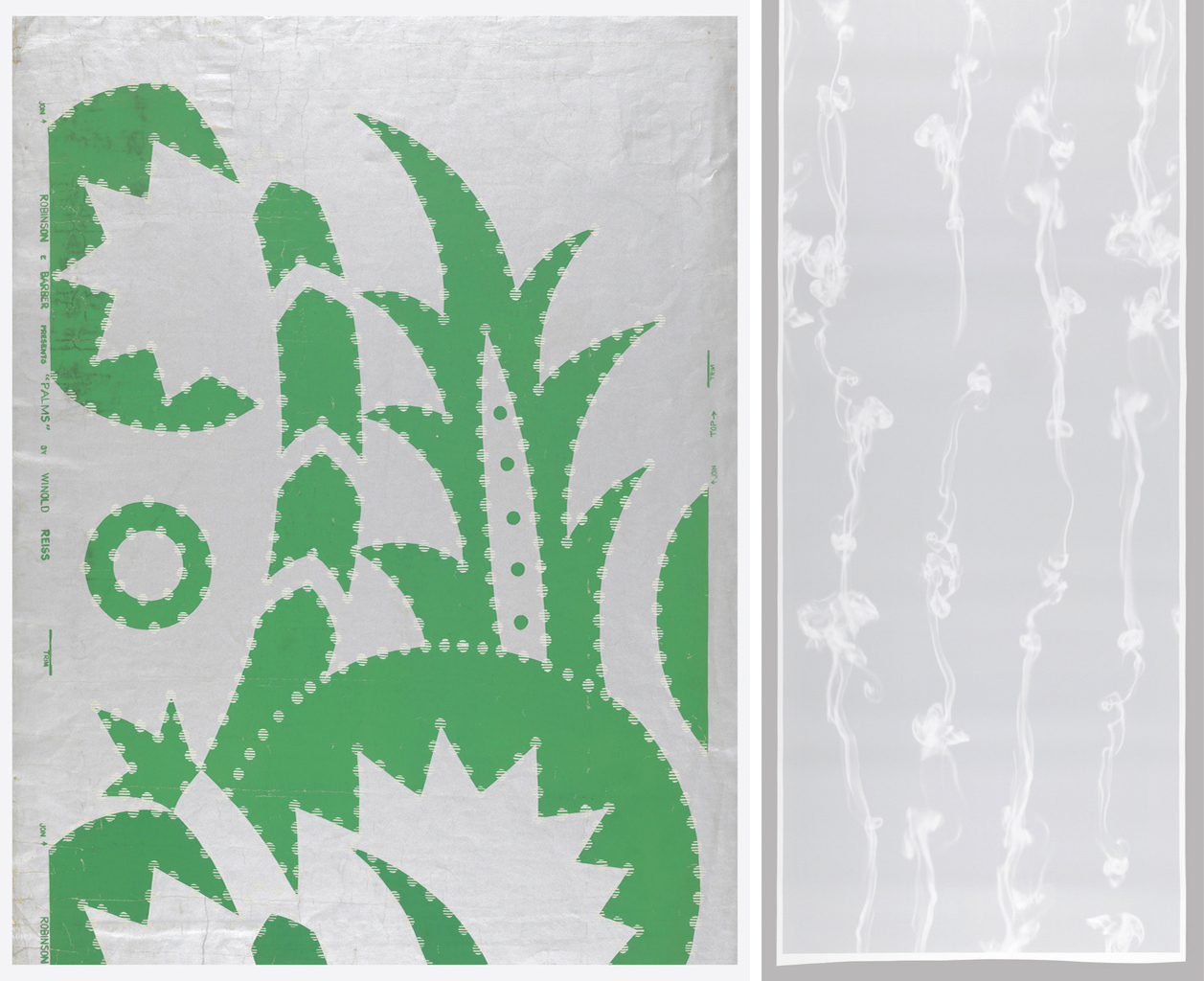
(left) Early screen-printed wallpaper, Palms, 1947; Designed by Winold Reiss (American, b. Germany, 1886–1953), made by Robinson & Barber (American); Gift of Robinson and Barber, 1947-80-8. (right) Contemporary digital print wallpaper, Ara, 2009; Made by Trove (New York, New York, USA); Gift of Trove, 2009-32-2.
And the best news is wallpapers can still be found today printed with any of these techniques, making it easy to find the perfect wallpaper to customize your home.
Sources
FN 1. Lynes, Russell, More Than Meets the Eye, The History and Collections of Cooper-Hewitt Museum, Eastern Press, Inc., 1981
FN 2. Cooper Union Chronicle, Vol. 1, No. 4, April 1938

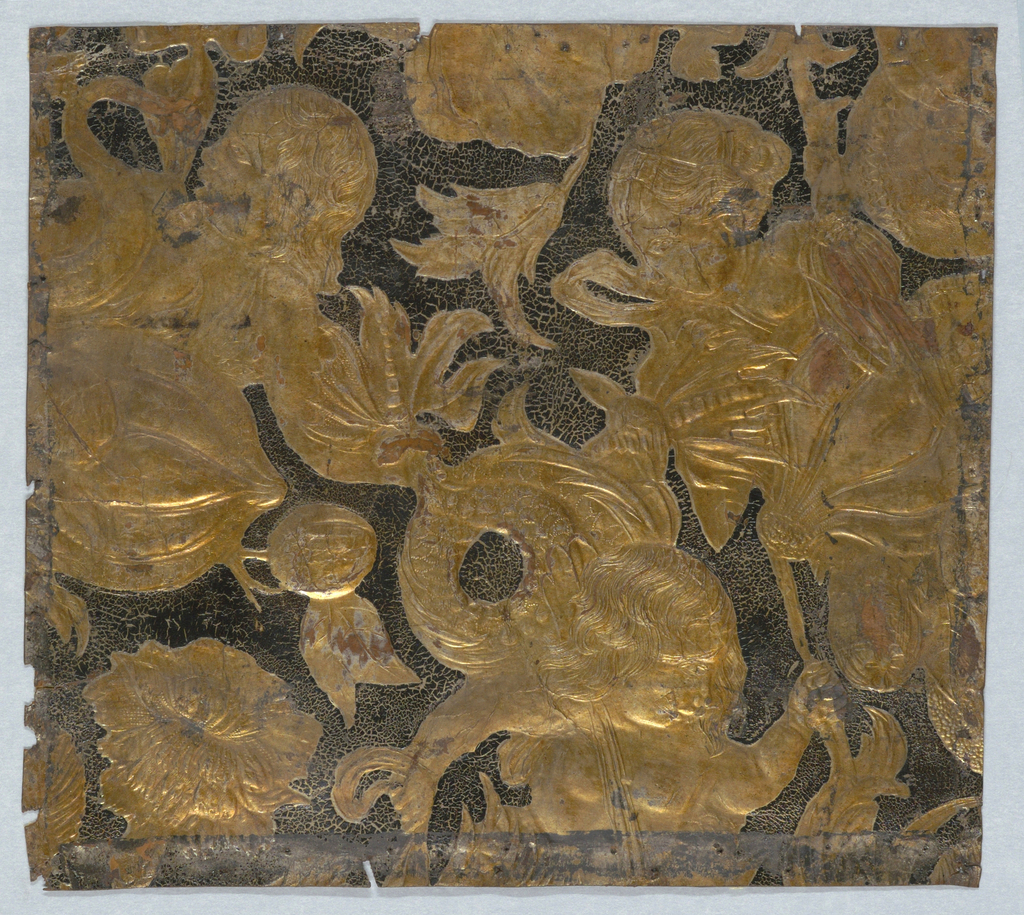
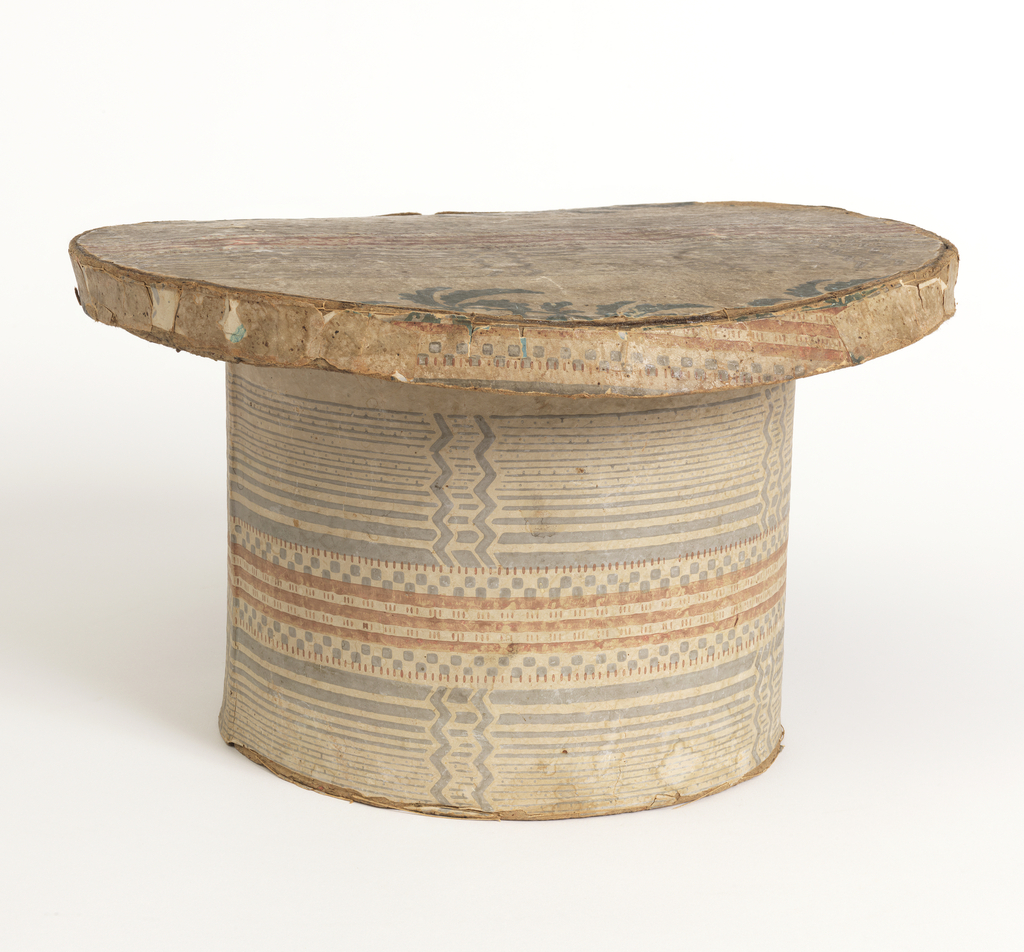
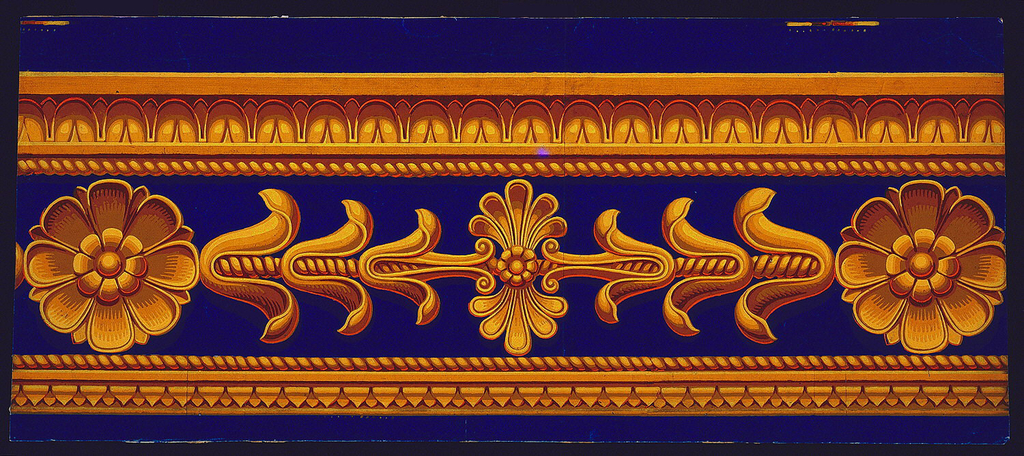
One thought on “Cooper Hewitt Short Stories: Hewitt Sisters Collect Wallcoverings”
Cooks Baggs on December 17, 2017 at 10:02 am
Mary Quinn Sullivan was a founder and trustee of MoMA, not a ‘founding member’.